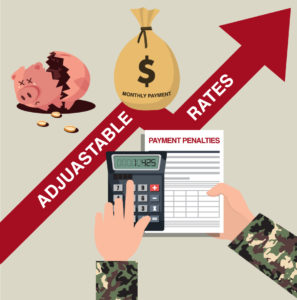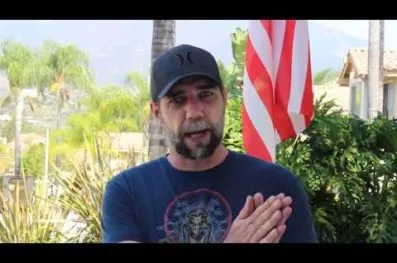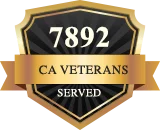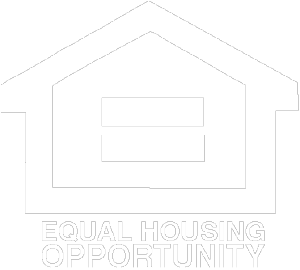VA Adjustable Loan Rates

Va Loans
REAL ESTATE FOR VETERANS
VA Adjustable Rate Loans: Is a 3-yr or a 5-yr VA Adjustable Rate right for you?

Peter Van Brady
Founder of SoCal VA Homes
Author: Avoiding Mistakes & Crushing Your Deals Using Your VA Loan
Once you know you want to use a VA loan to purchase or refinance your home, it’s time to figure out which type of VA loan is going to best suit your situation. The right fit will depend on the answers to several questions, such as: How long do you plan to stay in your home? Is the initial fixed rate term long enough to meet your needs? How much risk are you comfortable tolerating? What is the cost of the loan? To help you decide, here’s a closer look at VA adjustable rate loans, and why you may want to choose this option.
How do VA adjustable rate loans work?
VA adjustable rate loans (ARMs) work fundamentally like any other kind of ARM. They have interest rates that change every year based on market conditions. If interest rates have gone up, then the rate on your adjustable loan will go up along with your monthly mortgage payment. On the other hand, if interest rates have fallen your rate will drop and your mortgage payment will go down. ARMs often start with rates that are lower than fixed-rate mortgages. However, in the long run (say, over a 30-year term), they tend to end up higher.
Fixed vs. ARM
Unlike ARMs, fixed-rate mortgages have the same interest rate for the whole term. If you go with a fixed-rate loan, you’ll always know what your mortgage payment will be, which can make it easier to budget. However, you pay a price for that predictability. Rates often start higher than with ARMs. Additionally, if interest rates fall, you’ll be stuck paying a higher rate unless you refinance, which can cost you thousands in fees.
What is a VA hybrid ARM loan?
VA hybrid ARM loans are adjustable loans which combine elements of both fixed rate and adjustable rate loans. They have an initial period where the interest rate is fixed, which lasts for three years or five years. After that, the interest rate is readjusted every year, just like a regular ARM.
The two different types of hybrid ARMs, known as a 3/1 ARM and a 5/1 ARM. The first number tells you how long the rate is fixed and the second tells you how often the rate will adjust after the fixed period.
Hybrid VA ARMs often come with competitive rates for the initial fixed period. However, depending on the terms of the loan, the rate can jump up to 1% after the fixed period ends. These can be a good fit if you plan to sell or refinance the home before the fixed period ends or plan on having an increase in income within that period.
A reason not to choose the VA hybrid loan
One disadvantage that you almost never hear about is the actual “price” of the VA hybrid loan. These loans are less likely to stay on a lender’s books for as long as a fixed rate loan, so they are not as “valuable” to investors. (All VA loans are ultimately purchased as investments by GNMA though the securitization process.) Because the loans are not as valuable, not as much “secondary market premium” is offered on this loan product. This premium or “extra money” can be used to offset some or all of the closing costs. Learn more about offsetting costs with VA zero cost loans.
Most VA loan originators won’t discuss the specifics on this topic because it’s complicated. In the past, we have even witnessed one company use the low VA ARM rates to seduce unsuspecting Veterans, only selling much higher priced VA ARM loans. These customers were not given any accurate cost comparisons of how valuable the “secondary market premium” can be when offsetting closing costs on their VA loan rate choices for 30-yr fixed products vs ARMs. The cost comparison was purposely masked during in-home presentations with charts and graphs, and the Veteran borrowers were unfortunately duped with a lop-sided sales presentation.
We discovered this in 2011 and began specifically reaching out to those Veterans. We were able to help dozens & dozens of these California Veterans correct their choices with new “no cost” fixed rate loans. Each and every one of those Veterans regretted their original decision to refinance to the VA ARM with that company and pay the high closing costs, “and said it sounded good at the time.”
As you can imagine, the ability for a lender to contribute towards closing costs can be very valuable to Veterans when performing a Streamline Refinance or VA purchase.
What are the 3 types of caps on VA ARMs?
VA ARMs can’t adjust endlessly. They have three types of adjustment maximums, known as caps.
- The initial adjustment cap limits how much your interest rate can increase after the fixed-rate period ends. If you have a VA ARM, your initial adjustment cap will be 1%.
- The subsequent adjustment cap dictates how much your interest rate can go up every year after the first adjustment. The VA also sets this cap at 1%.
- The lifetime adjustment cap places a limit on how much your interest rate can increase over the whole term of the mortgage. This lifetime cap for is usually 5%.
These caps can help ensure that you don’t end up with a monthly mortgage payment you can’t afford.
Is a VA adjustable rate loan right for you?
VA adjustable rate loans , also known as VA hybrid ARMs can be a great option for military service members as they often provide competitive rates in the beginning. If you plan to sell your home before the full term is up, you may not see too high of an increase in your rate. Plus, you are protected to some degree by the adjustment caps. However, if you want to keep your home for the long haul and prefer more predictability, even though the initial rates are typically higher, a fixed rate loan will likely be a better fit.
Call 949-268-7742 today to speak with a Sr. VA Loan Technician at SoCal VA Homes and get professional help regarding your VA loan choices!
As Seen on ABC 10 5:00 O’Clock News













